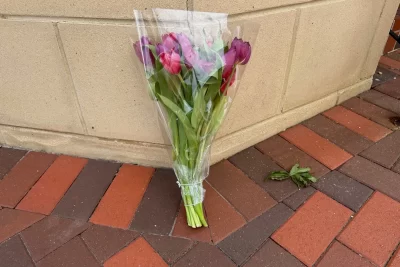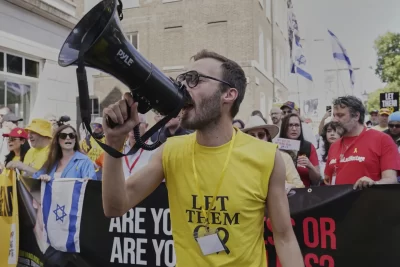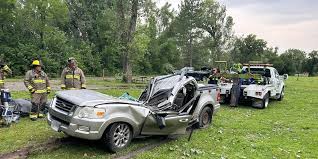
A camera livestreaming the skyline of Gaza City captures streaks of light. Dash-cam video from a car in Israel spots a killer coming into view. A satellite identifies tank tracks in the dirt, and a mall security camera catches the moment a bomb in Gaza detonates.
While journalists’ access to the war in Gaza is limited, a flood of video from all sorts of sources documents what is — and isn’t — going on.
At news organizations, sifting through material found online to determine what is real, and to unearth the sometimes unexpected clues that can be used to tie stories together, are increasingly important — and often emotionally overwhelming — jobs.
“It has become a key part of doing journalism in the modern age,” said Katie Polglase, a London-based investigative producer for CNN.
CBS News last week announced the launch of “CBS News Confirmed,” the formation of a team to use data and technology to study online evidence. Earlier this year, the similar “BBC Verify” unit was formed to bring more open source reporting methods to the worldwide news outlet.
There was no unanimity — and some caution about drawing conclusions absent an ability to examine evidence on the ground.
NO LONGER JUST ON THE SCENE
In an earlier era, viewers generally saw the aftermath of a news event unless television cameras happened to be on the scene. Now, with millions of people carrying phones that have video cameras, the aftermath isn’t good enough. The buzzword is “now.”
“The reality is that audiences expect to participate in a shared viewing experience, to learn what is going on along with anchors and reporters,” said Wendy McMahon, president of CBS News and Stations.
That means combing through an endless supply of video posted on sources like X (formerly Twitter), YouTube, Instagram, Telegram and Facebook. Much is harrowing: images of mangled bodies, bloodied children carried out of rubble, people distraught at the loss of loved ones. The effect of seeing such images is known by those who must watch them frequently as “vicarious trauma.”
Combatants know well the power of such images, which explains why some Hamas members wore cameras to document their Oct. 7 killing spree in Israel. Meanwhile, Israel compiled and has been showing grisly images of that day to journalists.
“The degree to which social media has been used is very sophisticated,” said Rhona Tarrant, senior editor at the investigative site Storyful. “There’s so much information. There’s so much content.”
News organizations are constantly weighing their job to convey reality against the concern that violent images are too traumatizing for consumers to see. Too much can desensitize viewers. Yet sometimes the repetition — the ongoing grind of war — is a story in itself.
Through images that have appeared online in recent weeks, people “learned” about Bella Hadid, a model of Palestinian descent, denouncing Hamas’ attack in Israel; a row of supposed bodies of dead Palestinians covered in white shrouds where one mysteriously moved; and a Palestinian “actor” seriously wounded in a hospital bed one day and walking unharmed the next.
None of it happened. All of the images were fake.
Video of Hadid accepting an award for activism in Lyme Disease was manipulated to make it seem like different words were coming from her mouth. The “moving body” video came from a 2013 protest rally in Egypt. The supposed “actor” was two separate people, and the image of one in a hospital bed preceded the start of the war.
That’s where the sleuthing skills of journalists studying video comes into play. Much of what is online now comes from past conflicts, including in Gaza itself, being passed off as new; search engines exist to help determine the truth. Sometimes images from video games are passed off as real, but experts can usually spot them.
“This war in many respects has confirmed our working assumption, that news organizations would see an influx of deep fakes and misinformation at a scale that was never seen before,” McMahon said.
HOW POTENT IS AI’S POWER?
Although the advance of artificial intelligence is a great fear, some experts says its use so far in this war has been limited in comparison to, say, old video being passed off as new. “People believe that AI is more powerful than it is at the moment,” said James Law, editor-in-chief at Storyful.
While debunking falsehoods is a big part of what journalists are doing, the use of video and other publicly available material — the definition of open-source reporting — has also come into its own in recent weeks.
Storyful, which formed in 2009 to help news organizations make sense of all that is out there, is particularly adept at this new form of detective work. Its investigators use many tools, including mapping software, flight-tracking, security cameras, news agency videos.
Often people are shooting footage, and something else that happens to be there — like leftover fragments from a bomb — can be clues for another story entirely, Polglase said.
Maps, video and audio from different sources can be pulled together for stories on how particular events unfolded, such as the Hamas attack on an outdoor concert the morning of Oct. 7. CNN’s investigation of this event, for example, illustrated how concertgoers were directed toward shelters they thought would be safe but turned out to be killing grounds.
The New York Times used video and Telegram postings to show how false claims that Israelis were going to settle in a Muslim area of Russia led to a mob attacking a plane.
Satellite images, video and photos helped The Washington Post track where Israeli forces went during their initial incursion into Gaza. Through videos and reporting, the BBC told about four sites in southern Gaza that were bombed and checked to see what kind of warning Israel offered to civilians that it was coming.
Part of the “CBS News Confirmed” initiative involves the hiring of journalists who are skilled in this type of reporting. Beyond concentrating on specific teams, organizations like the AP and BBC are training journalists throughout the world in some of these techniques.
Yet some of this work comes with a price. News outlets have long worried about the physical safety of journalists stationed in war zones, and are now becoming cognizant that spending hours watching disturbing video can be an emotional drain.
The investigative site Bellingcat tells employees to protect their mental health. “Always ask yourself if there is a genuine reason you need to view this footage,” advises Charlotte Maher, its social media critic. And one expert offers this advice: Turn off the sound after hearing something once because the audio can be as disturbing as what can be seen.
At Storyful, employees area encouraged to talk about what they’re going through and take advantage of counseling services if needed, all under a common message: You don’t need to just suck it up. Says Tarrant: “It certainly does take a toll on the team.”





